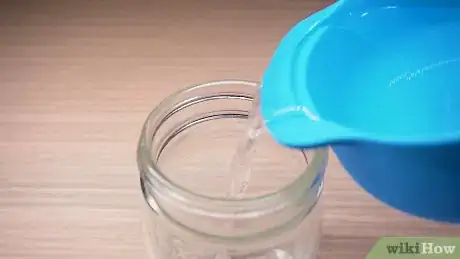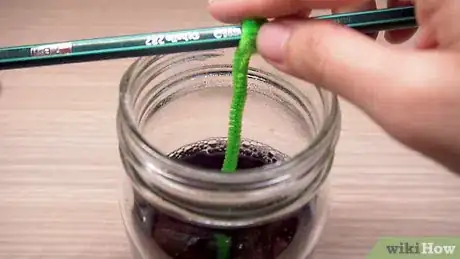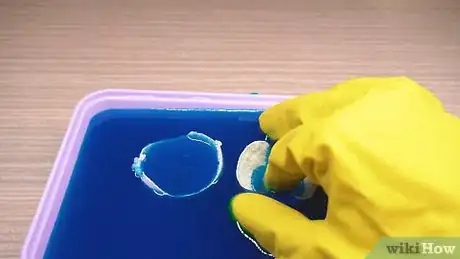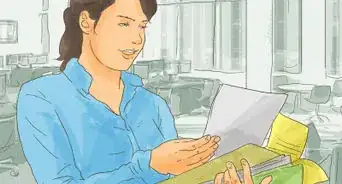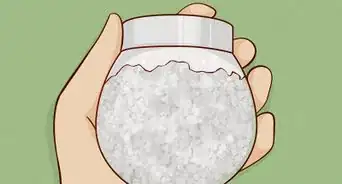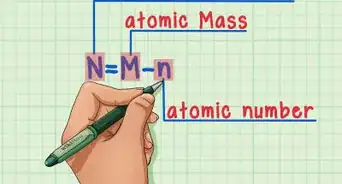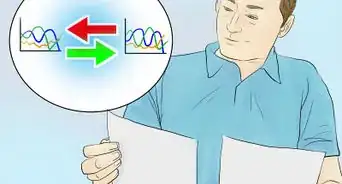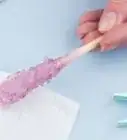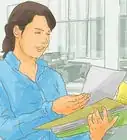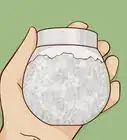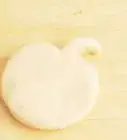This article was co-authored by Bess Ruff, MA. Bess Ruff is a Geography PhD student at Florida State University. She received her MA in Environmental Science and Management from the University of California, Santa Barbara in 2016. She has conducted survey work for marine spatial planning projects in the Caribbean and provided research support as a graduate fellow for the Sustainable Fisheries Group.
There are 10 references cited in this article, which can be found at the bottom of the page.
This article has been viewed 131,986 times.
Crystals are beautiful, eye-catching structures that are fun to look at and even more fun to grow at home. If you want to make your own, you can easily try growing simple crystal structures with borax, which is a cleaning product. For a different type of crystal, you can even make your own geode out of alum, which is a type of spice, and the shell of an egg.
Things You Should Know
- You can grow your own crystals at home using borax and hot water.
- Alternatively, you can use alum geodes.
- Use food coloring to add color to your homemade crystals.
Ingredients
- 1 cup (240 mL) of hot tap water (boiled) per crystal
- 3 tablespoons (77.8 g) of borax per crystal
- 5-10 drops of food coloring per crystal (optional)
- 1 egg, cracked or cut in half
- Craft or school glue
- 2 cups (470 mL) of water per crystal
- 1 pinch of crystal alum per crystal
- 3/4 cups (156 g) of crystal alum per crystal
- 40 drops of food coloring per crystal
Steps
Forming Borax Crystals
-
1Fill a jar with 1 cup (240 mL) of hot tap water. Pour 1 cup (240 mL) of tap water into a pot on the stove and heat it until it boils. Then, turn off the stove, let the water sit until it stops boiling, and pour it into a glass jar with a wide mouth that you can balance a pencil on. As the water cools, the borax will attach to any fibers in the water, like string or pipe cleaner, and other borax particles, which forms hard crystals.[1]
- It’s important to use the right amount of water in proportion to the borax so you can make a “supersaturated” solution. This means that there are more solid particles in the water than the water can dissolve.
- If you use more than 1 cup (240 mL) of water, you can add more borax to ensure that the solution is supersaturated [2]
Borax can be harmful if it touches your eyes or is inhaled, so it’s safer to add it to water that’s no longer boiling, but still just as hot.
-
2Add 3 tbsp (77.8 g) of borax to the jar, stirring until most of the borax dissolves. When you add it to the jar, let the borax settle at the bottom. Then, use a spoon or a glass stirrer to combine the water and borax. You should still be able to see white powder floating in the water after stirring for 5-10 seconds.[3]
- If you don’t see the powder floating in the water after you stir, add another 1/2 tablespoon (13 g) of borax to oversaturate the water.
- Be sure to purchase the powder borax from the laundry aisle of the supermarket. Other forms of borax, like borax soap, won’t work for making crystals.
Advertisement -
3Stir in 5-10 drops of liquid food coloring if you want colored crystals. Pick 1 color for each jar to avoid making muddy colors that can look brown when crystallized. Remember to stir the solution for a few seconds to distribute the color evenly throughout the jar.[4]
- The more drops of food coloring you add to the water, the brighter the color will be. However, if you add too much, your crystals may be smaller because the water becomes less saturated as you add the food coloring.
-
4Make a shape out of pipe cleaner and tie it to a pencil to make an ornament. Bend a pipe cleaner into a simple shape, like a star, heart, square, or circle. Attach a short piece of pipe cleaner to the top of your shape by wrapping it around the top point, and then wrap the other end of the pipe cleaner around a pencil.[5]
- This will allow the pipe cleaner to dangle in the water without touching the sides of the jar.
-
5Tie a 2 to 3 in (5.1 to 7.6 cm) piece of string to a pencil for longer crystals. Cut a piece of string to fit inside the jar for the borax to attach to. Then, tie one end around the center of a pencil so it can dangle in the water.[6]
- If you don’t have string, you can use a piece of yarn or even a straight piece of pipe cleaner wrapped around the pencil.
- Make sure the string is short enough so that it doesn’t touch the bottom of the jar.
-
6Lower the pipe cleaner or string into the jar, resting the pencil on the rim. Hold the pencil horizontally, and carefully move the pipe cleaner or string through the mouth of the jar and into the water. Place the pencil on the top of the jar, and look into the jar to make sure the string or pipe cleaner isn’t touching the side or bottom of the jar.[7]
- If it is, adjust the position of the pencil by moving it to one side, or try re-lowering the item into the water.
-
7Let the crystals grow for 1-2 days before removing them from the jar. Place the jar in a place that is out of the way so the crystals can grow undisturbed for at least 24 hours. After the first day, check on the crystals to see how large they are, and leave them in the solution for up to 2 days to grow larger crystals.[8]
- If you notice the crystals are touching the side or bottom of the jar, remove them from the solution to prevent them from growing too large to get out of the container.
-
8Cut the piece of string or pipe cleaner to display your crystals. The crystals have formed around the fibers of the pipe cleaner or string, so you can safely remove them from the pencil. Simply use a pair of scissors to cut through the top of the string or pipe cleaner, and place your crystals near a window to see its beautiful structure.[9]
- You can hang the pipe cleaner ornament in a window to make a unique suncatcher.
Making Alum Geodes
-
1Crack or cut 1 egg in half widthwise and carefully rinse out the shells. Over a sink, use a sharp knife to cut through the shell and empty the egg into the drain. If you want a more asymmetrical look, simply crack the egg in half with your hands. Then, run the egg shell halves under warm water to remove any residue.[10]
- Be careful when handling the egg shells. They’re very brittle and can crack and break easily if you hold them too tightly or drop them.
-
2Use a cotton swab to spread a layer of glue on the inside of the shell. Use a small drop of craft glue or school glue on a cotton swab. Make sure the layers are thin and cover the entire surface area where you want the crystals to grow.[11]
- If you don’t have a cotton swab, you can use a small paint brush to spread the glue.
-
3Sprinkle a pinch of alum inside of each shell and let the glue dry overnight. Make sure the glue is completely coated with alum, which you can find in the spice aisle of the supermarket. Then, leave the shells undisturbed for at least 6 hours to dry the glue.[12]
- The alum on the egg will bond with alum in the water as the water cools, forming a beautiful geode-like structure.
- It’s important that the glue is completely dry before you grow the crystals. You can check to see if the glue is dry by touching the inside of each egg with your fingertip to see if the alum feels moist.
-
4Boil 2 cups (470 mL) of water and transfer it into a container. About 2 minutes after the water begins to boil, remove it from the heat. Let it cool for 2 minutes, then pour it into a plastic container. Make sure you use a disposable one, since the food coloring and alum can change the color of the container.[13]
- Always be careful when handling and pouring boiling water. It can easily splash onto your hands and arms, causing burns.
-
5Stir in 3/4 cups (156 g) of alum, letting the solution cool for 30 minutes. Use a spoon to stir the solution until all of the crystals are dissolved. Touch the sides of the container every few minutes to check that the water is getting cooler.[14]
- The water doesn’t have to be room temperature, but it should be cool enough for you to dip a finger into the water.
-
6Add 40 drops of food coloring if you want colored crystals. If you plan to make colorful geodes, don’t forget to stir in the liquid food coloring. Only add 1 color at a time to the crystals to prevent them from becoming a muddy brown color as they grow.[15]
- Colors like blue, purple, green, and pink tend to show up well in the alum crystals. Lighter colors like yellow likely won’t appear very bright once you remove them from the water.
-
7Submerge an eggshell in the solution with the open side facing up. Put on a pair of latex or rubber gloves and carefully lower one of the shells into the water. Adjust it with your hands so that the open part is facing the top of the water as much as possible.[16]
- Don’t worry if the shell shifts to one side or the other, as long as it’s generally positioned with the open side up.
- If you reach into the water without gloves on, you can stain your hands due to the alum and food coloring.
-
8Leave the shell in the container overnight to grow before removing it. Try not to move the containers while the crystals grow, as this can cause the egg to shift. When you’re ready to remove the crystals, put on a pair of gloves and pull the shell out of the solution, placing it on a paper towel to air dry for at least an hour.[17]
- After 12 hours, you should be able to see sizable crystals on the shell, and you can leave them in the solution for up to 24 hours to grow a larger geode.
- The eggshell should be able to rest at the bottom of the container with the inside facing up. If it won’t stay, you can also try carefully pouring the solution into the egg and letting it dry on a flat surface covered by newspaper.[18]
Expert Q&A
-
QuestionHow do you make a spiky crystal?
 Bess Ruff, MABess Ruff is a Geography PhD student at Florida State University. She received her MA in Environmental Science and Management from the University of California, Santa Barbara in 2016. She has conducted survey work for marine spatial planning projects in the Caribbean and provided research support as a graduate fellow for the Sustainable Fisheries Group.
Bess Ruff, MABess Ruff is a Geography PhD student at Florida State University. She received her MA in Environmental Science and Management from the University of California, Santa Barbara in 2016. She has conducted survey work for marine spatial planning projects in the Caribbean and provided research support as a graduate fellow for the Sustainable Fisheries Group.
Environmental Scientist The crystal will grow based on the shape you submerge in the jar. If you want a crystal with pronounced spikes, you could take a single pipe cleaner and twist smaller lengths of pipe cleaner onto so that they're sticking straight out, perpendicular to the longer piece.
The crystal will grow based on the shape you submerge in the jar. If you want a crystal with pronounced spikes, you could take a single pipe cleaner and twist smaller lengths of pipe cleaner onto so that they're sticking straight out, perpendicular to the longer piece. -
QuestionSo for the first two methods i have to over-saturate the solutions?
 Bess Ruff, MABess Ruff is a Geography PhD student at Florida State University. She received her MA in Environmental Science and Management from the University of California, Santa Barbara in 2016. She has conducted survey work for marine spatial planning projects in the Caribbean and provided research support as a graduate fellow for the Sustainable Fisheries Group.
Bess Ruff, MABess Ruff is a Geography PhD student at Florida State University. She received her MA in Environmental Science and Management from the University of California, Santa Barbara in 2016. She has conducted survey work for marine spatial planning projects in the Caribbean and provided research support as a graduate fellow for the Sustainable Fisheries Group.
Environmental Scientist Yes. You want there to be more solid particles than the water can dissolve, so that the crystals can form.
Yes. You want there to be more solid particles than the water can dissolve, so that the crystals can form. -
QuestionWhat is the strongest type of crystal?
 Community AnswerWurtzite boron nitride and lonsdaleite (hexagonal diamond) are the two strongest.
Community AnswerWurtzite boron nitride and lonsdaleite (hexagonal diamond) are the two strongest.
Things You’ll Need
Forming Borax Crystals
- Wide-mouth jar
- Pipe cleaner or string
- Pencil
- Spoon or stirrer
Making Alum Geodes
- Cotton swab or paint brush
- Craft or school glue
- Disposable plastic container
- Spoon or glass stirrer
- Latex or rubber gloves
References
- ↑ https://www.sciencefriday.com/educational-resources/lets-grow-some-crystals/
- ↑ https://sciencing.com/grow-borax-crystals-3866.html
- ↑ https://www.sciencefriday.com/educational-resources/lets-grow-some-crystals/
- ↑ http://www.bbbswnc.org/wp-content/uploads/2014/10/Borax-Crystal-Snowflake1-1.pdf
- ↑ http://www.bbbswnc.org/wp-content/uploads/2014/10/Borax-Crystal-Snowflake1-1.pdf
- ↑ https://www.sciencebuddies.org/science-fair-projects/project-ideas/Chem_p082/chemistry/how-to-grow-the-best-and-the-largest-crystals#procedure
- ↑ https://www.sciencefriday.com/educational-resources/lets-grow-some-crystals/
- ↑ https://www.indypl.org/blog/for-kids/science-experiment-saturation-growing-crystals
- ↑ http://www.bbbswnc.org/wp-content/uploads/2014/10/Borax-Crystal-Snowflake1-1.pdf
- ↑ https://www.parents.com/fun/arts-crafts/kid/how-to-make-crystal-geode-eggs/
- ↑ https://www.csub.edu/chemistry/_files/Alum%20borax%20espon%20salt%20egg%20geodesAO.pdf
- ↑ https://www.childrensmuseum.org/blog/saturday-science-crystal-egg-geode
- ↑ https://www.csub.edu/chemistry/_files/Alum%20borax%20espon%20salt%20egg%20geodesAO.pdf
- ↑ https://www.childrensmuseum.org/blog/saturday-science-crystal-egg-geode
- ↑ https://www.orl.bc.ca/docs/default-source/kids_teens/steam-activities/science---gorgeous-geodes.pdf?sfvrsn=eedf9e21_0
- ↑ https://www.csub.edu/chemistry/_files/Alum%20borax%20espon%20salt%20egg%20geodesAO.pdf
- ↑ https://www.csub.edu/chemistry/_files/Alum%20borax%20espon%20salt%20egg%20geodesAO.pdf
- ↑ https://sciencebob.com/eggshell-geode-crystals/
About This Article
To grow crystals, boil water and pour it into a glass jar. Next, add powdered borax to the jar and stir the mixture until most of the borax dissolves. Next, bend a pipe cleaner into a simple shape, like a star, heart, or circle, then wrap the other end of the pipe cleaner around a pencil. Lower the pipe cleaner into the jar, resting the pencil on the rim, and watch as your crystals start to grow. If you want to learn more, like how to make crystals using alum and eggshells, keep reading the article!
